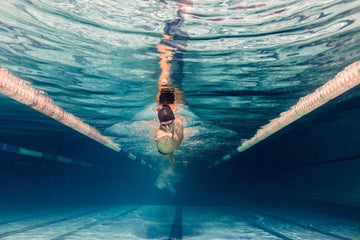Swimming is one of the most popular and healthy sports in the world. It is not only a recreational activity, but also a highly effective workout that uses the entire body. Whether you are a beginner or a professional athlete, swimming offers a variety of health and fitness benefits. In this post, we take a closer look at the positive effects of swimming, the different swimming styles and why swimming is an excellent addition to any fitness routine.
Benefits of swimming
1. Full body workout:
•Swimming trains almost every muscle in the body, from the legs to the torso and arms. The constant movement in the water ensures that all muscle groups are activated simultaneously. This makes swimming one of the most efficient full-body workouts there is.
2. Protect your joints:
•Unlike many other sports, swimming hardly puts any strain on the joints. In the water, the buoyancy relieves the strain on the body, which reduces the pressure on joints and bones. People with joint problems or injuries in particular benefit from this joint-friendly sport.
3. Improved cardiovascular fitness:
•Swimming is an excellent endurance exercise that strengthens the cardiovascular system. Regular swimming improves heart function, lowers blood pressure and can reduce the risk of cardiovascular disease.
4. Increase breathing capacity:
•Since breathing control plays a major role in swimming, lung capacity increases naturally. The deep, controlled breaths required when swimming train the respiratory muscles and promote the oxygen supply to the body.
5. Calorie burning and weight management:
•Swimming is an effective way to burn calories. One hour of vigorous swimming can burn up to 500-700 calories, depending on the intensity and swimming style, making it an excellent way to lose or maintain weight.
6. Stress relief and mental relaxation:
•Gliding through the water often has a calming effect and helps to reduce stress. Many people find swimming meditative as it relaxes both the mind and the body. The rhythmic movements and the sound of the water promote a feeling of calm.
Different swimming styles
1. Freestyle swimming:
•Crawl is the fastest and most common swimming style. It requires good coordination of arm movements, kicking and breathing technique. Crawl swimming particularly strengthens the back muscles, shoulders and core.
2. Breaststroke:
•Breaststroke is a slower but less strenuous swimming style that is particularly popular with beginners and recreational swimmers. It primarily trains the chest, back and leg muscles.
3. Backstroke:
•Backstroke is ideal for people who want to strengthen their back muscles while protecting their spine. It improves posture and relieves pressure on the neck and shoulders.
4. Butterfly:
•The butterfly stroke is the most technically demanding swimming style and requires a lot of strength, coordination and endurance. It trains the entire upper body, especially the shoulders, arms and back.
Tips for beginners
1. Learn the right technique:
•Correct swimming technique is crucial to swimming effectively and avoiding injury. It is worth taking a swimming class or a coach to learn the basics of the different swimming styles.
2. Start slowly:
•Swimming requires stamina and technique. It is important not to overexert yourself and to start slowly with short sessions. Over time, the intensity and duration of the training can be increased.
3. Control breathing:
•Breathing is an important aspect of swimming. Regularly practicing breathing techniques, especially in the front crawl and butterfly strokes, will help you swim longer and more efficiently.
Swimming as part of a balanced training plan
Swimming is a perfect addition to any fitness routine. It improves endurance, strengthens muscles and is a gentle alternative to intensive strength or endurance training. In combination with other sports such as running or cycling, swimming can help to make training more varied while reducing the risk of injury.
Conclusion
Swimming is a versatile and healthy sport that is suitable for people of all ages and fitness levels. It offers numerous physical and mental benefits, from improving cardiovascular fitness to relaxation and stress relief. Whether you are a beginner or an experienced swimmer, incorporating swimming into your regular fitness routine can contribute to better health and an improved quality of life in the long term.





